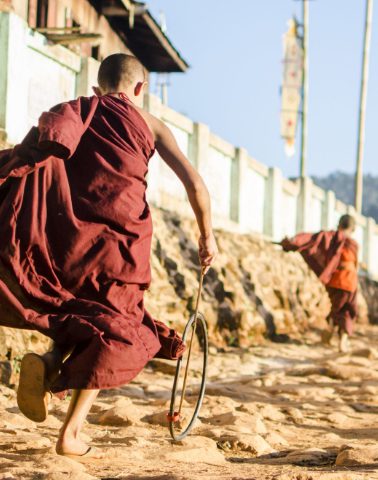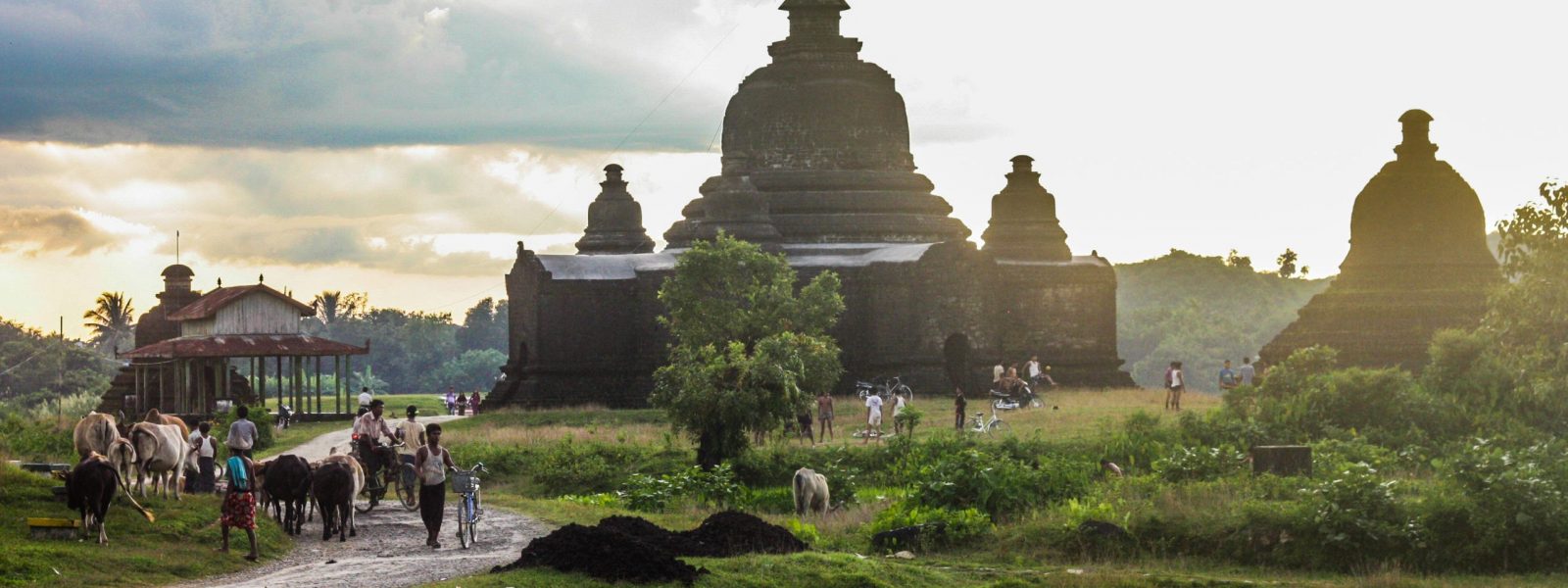
Subscribe to our mailing list
We are still here! Let us send you tips for travelling through Myanmar and stories from the road …
Forty-eight Rakhine kings ruled Mrauk U, protected by Japanese Christian bodyguards who had fled persecution in Nagasaki. With rival kingdoms both to the east and west, the city’s natural defenses were strengthened with the construction of numerous ramparts, moats and citadels. Artificial lakes were built on the east of the city so to flush out invading forces.
Prospering as a commercial and cosmopolitan hub for 355 years, Mrauk U became known to European traders as ‘the Golden City’, comparable in its grandeur to London and Amsterdam. It was once one of the richest cities in Asia and the Mrauk U dynasty was much feared by the people of the Indian subcontinent and central Myanmar. The Portuguese Jesuit Father A. Farinha, SJ described it as ‘a second Venice.’
Just a five-minute walk from Shittaung Paya, from the vantage point of a small hillock termed “Sunset Hill” one can look over the foundations of the old fortress as well as the smudged silhouettes of the Andaw and Htuk Kan temples.
What makes the scene so alluring is that, unlike in Bagan, regular town life continues in Mrauk U. In and around these spectacular ruins potter chickens; goats gamble, and children shouting to each other return from school on bicycles; girls go to fetch water from the well with curvaceous silver pots from Bangladesh balancing on their heads; men, women and children fill up buckets in the pond to shower themselves on the banks, while taxi drivers recline in the scruffy tea shops, smoking and chuckling and paying no attention to the sunset that entrances outsiders.
As if for the benefit of those on Sunset Hill, at dusk the farmers set alight their bonfires; a thick smell of charcoal fills the air and the scape is draped in an ephemeral mist. Amongst all this, there is perhaps a cowherd, clad in conical hat and checkered shirt, distracted from his watch by a camera trained upon him, into which he stares steadily back, diffident to the magnificent scene he stands in the centre of.
There are thought to be 6,352 pagodas in Rakhine State, the finest of which are to be found in Mrauk U. Shittaung Paya is perhaps the most spectacular, a labyrinthine complex the name of which means ‘Shrine of the 80,000 Images’.
This paya was built in 1535 and offers visitors a cacophony of stupas as well as statues of characters frozen in carnivalesque scenes. Here one can gaze upon stone carvings of kings and queens, courtiers and commoners, all dressed up in their traditional garb. You will be able to find men wrestling and girls dancing as well as animals and mythical creatures caught in the midst of great revelry.
Frescoes of life at the Mrauk U court can also be found in Lay Myet Nha and Shwe Daung Pagoda. Outside the temple is the Shittaung Pillar inscribed with Sanskrit, considered by the Rakhine to be the ‘oldest history book in Myanmar’.
Other sites that are also worth a visit include the ancient ruins of Versali (Wethali) known as ‘The Stone Stairs City’ founded in the 4th Century and subsequently prospered for some 400 years; the bustling Mahamuni Shrine; the topsy-turvy Mandula Monastery; Kohtaung Paya (‘Shrine of the 90, 000 Images’); and Htuk Kant Thein Temple, resembling a Portuguese fortress.
During the initial Burmese occupation of Rakhine (and since 1992 when the government made misguided attempted to render Mrauk U more appetizing to foreign palates) much of the idiosyncratic architectural style of the Buddhist buildings and images in Rakhine have been sullied with the Burmese penchant for gold-gilding and flashing neon lights.
Nonetheless, one is still able to notice a more puritan aesthetic in these temples, and the keen observer will notice that instead of the chinthe that guard the entrance to pagodas in the rest of Myanmar, in Rakhine this prestigious duty falls to ogres.
Those keen for further insight into ‘the Lost City of Mrauk U’ can take a look at the book The Land of the Great Image by the British author (and one-time administrator of Thanintharyi Division) Maurice Collins, recounting the time spent by the Portuguese missionary Friar Sebastien Manrique in Mrauk U between 1629 and 1653.

Though now largely isolated, for generations, Rakhine, first known as Arakan to the merchants from the West and subsequently commonly referred to as such, was a rich, cosmopolitan hub, prospering from a thriving sea trade and accepting people and ideas from across the continent.
The Mrauk U Kingdom was the successor to three earlier kingdoms of the region: Dhanyawady (1st to 6th Centuries AD), Wethali (3rd to 11th Centuries AD), and Lemro (11th to 15th Centuries AD). All four kingdoms merged elements of Theravada and Mahayana Buddhism with Islam and Hinduism.
Even with independence from Bengal, Mrauk styled itself as a sultanate. A hybrid Buddhist-Islamic court ruled over an eclectic population made up of Arakanese, Bengalis, Burmese, Afghans, Dutch, Portuguese and Japanese Christians from Nagasaki.
In 1404 Arakan was invaded by the Bamar Court of Ava, and their king Naramithla fled to the royal Bengali city of Gaur. He returned three decades later, routed the Burmese, and established Mrauk U as his capital with the support from the Sultanate of Bengal, leading to an influx of Indian cultural and political influence.
The Kingdom remained subordinate to Bengal until 1531 when the Mrauk U King Minbin sent an army of 12,000 to claim large swathes of land in modern-day Bangladesh. The great victory was celebrated by the building of the Shittaung Paya.
Even with independence from Bengal, Mrauk U styled itself as a sultanate. A hybrid Buddhist-Islamic court ruled over an eclectic population made up of Arakanese, Bengalis, Burmese, Afghans, Dutch, Portuguese and Japanese Christians from Nagasaki. When the Bengal sultanate fell on hard times in the 18th Century, Arakan began to flex its muscles. With a large navy that supported a burgeoning and lucrative slave trade, this new regional power took hold of most of Eastern Bengal, as well as pushing east and temporarily occupying Pegu (today’s Bago.)
In 1784, King Bodawpaya of the Court of Ava sent his son, the Crown Prince of Burma, to invade the Kingdom of Arakan. Over 30, 000 Burmese soldiers marched from Pyay through the mountains, suffering the monsoon rains. Though bereft of its former prowess, breaching the fortress of Mrauk U was still a formidable task. However with suspected inside help, by the end of the year the Burmese were in.
Looting and destruction on a horrific scale ensued sundering forever much of Arakan’s rich heritage and cultural artefacts. Thousands of inhabitants were carted back to Burma, while many others fled to British India. It was in pursuit of these refugees over the border that the Burmese first came into conflict with the British, ultimately leading to the First Anglo-Burmese War of 1824 – 26. Following this war, Arakan was Burma’s first segment to fall under British rule.
The slow boat between Mrauk U and Sittwe along the Kaladan River is an optimum way to view the Rakhine landscape. The countryside of Rakhine State is fertile and peppered with clumps of mango, guava and citrus trees.
When commencing from Sittwe, the trip will take between five and six hours. Cruising in the other direction will take a little longer. On the banks of the sprawling Kaladan lie large fields where buffalo munch and swish their tails contentedly, farmers emerge from little huts and boys skip along the bank and throw sticks into the water.
Sittwe appears like a city still in the grips of jungle. From the second floor of any building one can look over the cityscape and see as much creeping, green foliage as brick and mortar.
Sittwe is the capital of Rakhine State. It is pronounced ‘site way’ by locals and was formerly known as ‘Akyab’.
The Rakhine State Cultural Museum is no great shakes; the curating is drab and uninspiring, and most of the text is solely in Burmese. Visitors however should walk along the city’s promenade towards the ‘View Point’ where the Kaladan River meets the Indian Ocean. Past buildings of hopping, hook-nosed rooks and a handful of seafood restaurants one will reach ‘Fakir Point’ where there are patriotic statues, benches and a viewing tower. This is an optimum place to watch the sun melt into the Bay of Bengal at dusk, while local lads somersault into the waves.
One can also visit the vast fish market, where mammoth tuna are strung up to dry with their middle-sections sliced into thin strips. Down at the jetty one can watch the fishing boats come in and out with their load, while the opportunistic scavenge about in the shallows for catch that has slipped overboard.
The Rakhine (or ‘Arakanese’) are staunchly proud of their ethnicity and history, however both are today hotly debated. Whether the Rakhine have more in common with Indians, the Bamar, a Negrito tribe, or are to themselves a separate race is not merely a point of academic conjecture but is a large part of the State’s fierce politics.
Rakhine State is made up of a variety of ethnicities in addition to the Arakanese. A trained eye will be able to spot the different dress and facial features of the Mro, Thak, Daingnak, Khami and Shin (who should not be confused with the people of Chin State further to the north, despite the fact that the Shin women also tattoo their faces).
In June 2012, sparked by the rumoured rape of a Rakhine Buddhist girl, bloody riots erupted on the streets of Sittwe: the enraged Rakhine Buddhist majority against the principally Rohingya Muslim minority. Over the following few months 90 people were killed and 100, 000 Rohingya were displaced from Sittwe, exiled to camps outside of the town.
Sittwe’s once vibrant Muslim quarters are today eerily quiet. Not included as one of the official 135 ethnic groups of Myanmar (a number produced by General Ne Win and much derided as arbitrary outside of Myanmar), but instead as unwelcome Bengali immigrants brought over by the British, thousands of Rohingya remain in the Sittwe camps and trapped in Maungdaw and Buthidaung Townships to the northeast of Rakhine State. Special permits are required for outsiders to visit the camps in Sittwe, or Maungdaw and Buthidaung Townships.
On August 25th 2017, attacks coordinated by the Arakan Rohingya Salvation Army (ARSA) on police posts incited a fierce retaliation by the Myanmar Armed Forces, the Tatmadaw. This clearance operation led to almost 700, 000 Rohingya fleeing across the Bangladeshi border to Cox’s Bazaar, and provoked the UN Special Rapporteur on the situation of human rights in Myanmar to report that the Tatmadaw’s operations against the Rohingya bore ‘the hallmarks of genocide.’
The ensuing Rohingya crisis continues to deter many people from travelling to Myanmar. Without denying the horrors of what has been happening, Sampan Travel continues to encourage people to visit this country, believing that responsible tourism can be a small force for good. Sampan’s Managing Director Bertie Alexander has written down in full why he believes that travelling to Myanmar is still the right thing to do.
For in-depth and accurate reporting of Myanmar’s politics, we recommend Frontier.